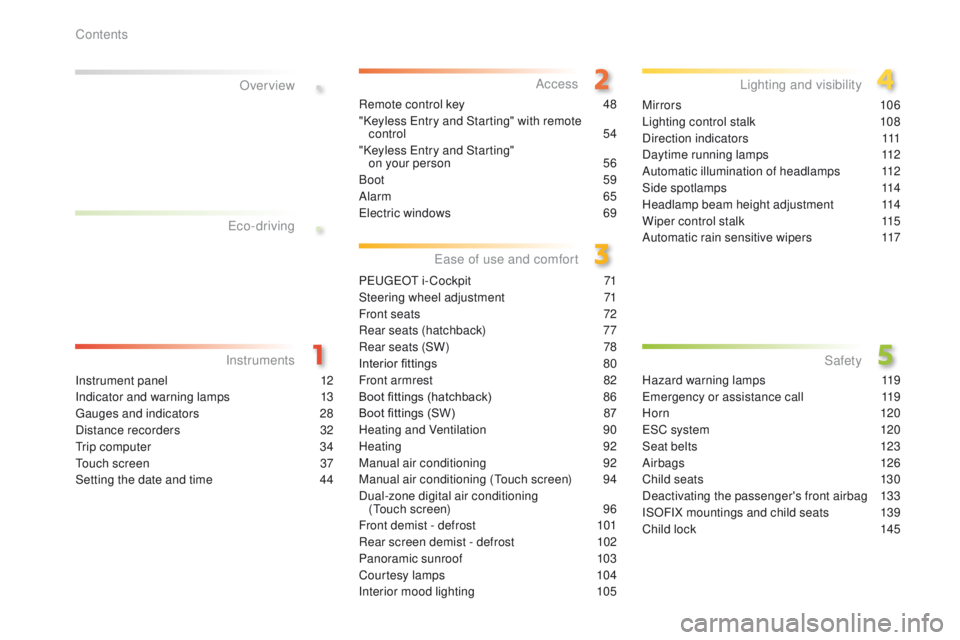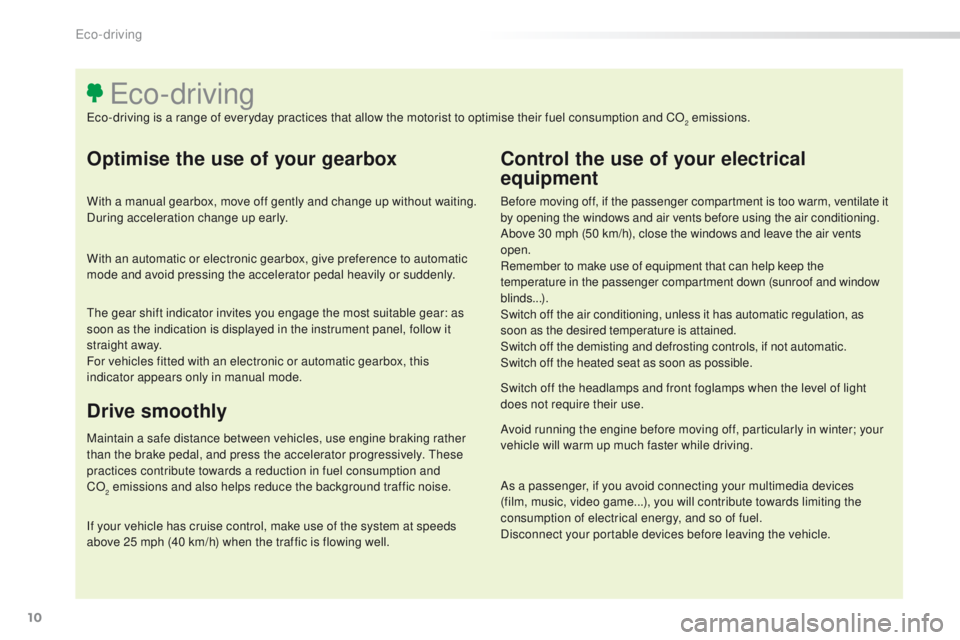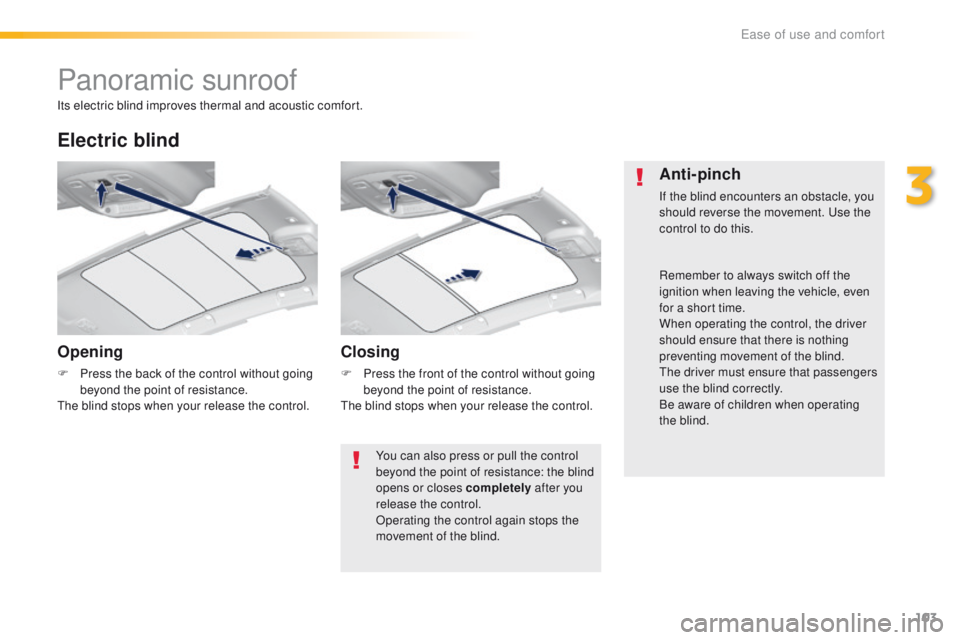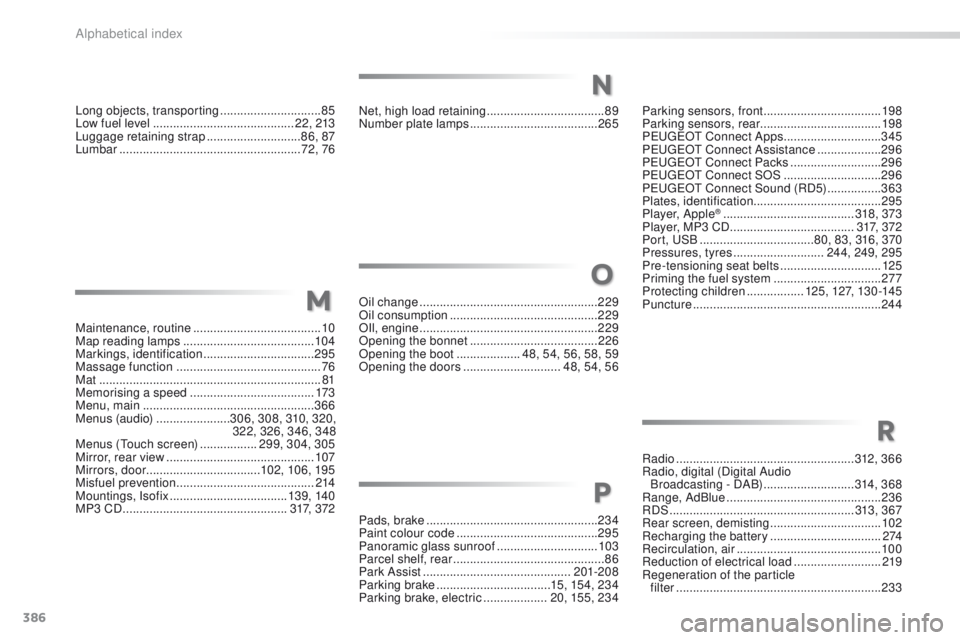2016 Peugeot 308 sunroof
[x] Cancel search: sunroofPage 4 of 398

.
.
Over view
Instrument panel 12
Indicator and warning lamps
1
3
ga
uges and indicators
2
8
Distance recorders
3
2
tr
ip computer
3
4
to
uch screen
3
7
Setting the date and time
4
4Remote control key
4
8
"Keyless e
n
try and Starting" with remote
control 54
"Keyless e
n
try and Starting"
on your person
5
6
Boot
59
Alarm
65
el
ectric windows
6
9
P
e
uge
Ot
i- Cockpit
7
1
Steering wheel adjustment
7
1
Front seats
7
2
Rear seats (hatchback)
7
7
Rear seats (SW)
7
8
Interior fittings
8
0
Front armrest 8 2
Boot fittings (hatchback)
8
6
Boot fittings (SW)
87
H
eating and Ventilation
9
0
Heating
9
2
Manual air conditioning
9
2
Manual air conditioning (
to
uch screen)
9
4
Dual-zone digital air conditioning (
to
uch screen)
9
6
Front demist - defrost
1
01
Rear screen demist - defrost
1
02
Panoramic sunroof
1
03
Courtesy lamps
1
04
Interior mood lighting
1
05Mirrors
10 6
Lighting control stalk
1
08
Direction indicators
1
11
Daytime running lamps
1
12
Automatic illumination of headlamps
1
12
Side spotlamps
1
14
Headlamp beam height adjustment
1
14
Wiper control stalk
1
15
Automatic rain sensitive wipers
1
17
Hazard warning lamps 1 19
em
ergency or assistance call
1
19
H or n
12
0
e
SC system
1
20
Seat belts
1
23
Airbags
1
26
Child seats
1
30
Deactivating the passenger's front airbag
1
33
ISOFIX mountings and child seats
1
39
Child lock
1
45
eco-driving
In struments Access
ea
se of use and comfort Lighting and visibility
Safety
Contents
Page 6 of 398

4
exterior
W i p e r s 115 -118
Changing a wiper blade 1 18, 222
Keyless
e
n
try and Starting
remote control
5
4-58, 61- 63
Remote control key
4
8 -53, 63
Starting
1
48-154
ele
ctronic stability
control (
e
SC)
1
20 -122
Snow chains
2
16
ty
re pressures
2
44, 255, 295
Inder-inflation detection
20
9-212
Changing a wheel
2
50-255
-
tools
-
r
emoving / refitting
Automatic emergency braking
19 0 -19 4
Lighting
108-114
Daytime running lamps (L e
D
s)
1
12
Headlamp beam adjustment
1
14
Changing bulbs 2 56-260
- f ront lamps
-
foglamps
-
d
irection indicator repeaters
Very cold climate screen
2
17
el
ectric windows, deactivation
6
9-70
Keyless e
n
try and
Starting
54-58
Doors
4
8 -50, 52
-
ope
ning / closing
-
c
entral locking
-
em
ergency control
Alarm
65-68
Fuel tank, misfuel prevention
2
13-215
Panoramic sunroof
1
03
Roof bars, bicycle carrier
2
23 -224
Accessories
2
20-221
Boot
59-60
-
ope
ning / closing
-
em
ergency release
te
mporary puncture
repair kit
2
44-249
Warning triangle
2
43
Parking sensors
1
98-199
Reversing camera
2
00
to
wbar
1
47, 218
to
wing
2
75 -276
Park Assist
2
01-208
Changing bulbs
2
61-265
-
r
ear lamps
-
3
rd brake lamp
-
n
umber plate lamps
-
foglamp Door mirrors
1
06, 114
Blind spot sensors
1
95 -197
Over view
Page 12 of 398

10
Optimise the use of your gearbox
With a manual gearbox, move off gently and change up without waiting.
During acceleration change up early.
With an automatic or electronic gearbox, give preference to automatic
mode and avoid pressing the accelerator pedal heavily or suddenly.
Control the use of your electrical
equipment
Before moving off, if the passenger compartment is too warm, ventilate it
by opening the windows and air vents before using the air conditioning.
Above 30 mph (50 km/h), close the windows and leave the air vents
open.
Remember to make use of equipment that can help keep the
temperature in the passenger compartment down (sunroof and window
blinds...).
Switch off the air conditioning, unless it has automatic regulation, as
soon as the desired temperature is attained.
Switch off the demisting and defrosting controls, if not automatic.
Switch off the heated seat as soon as possible.
Switch off the headlamps and front foglamps when the level of light
does not require their use.
Avoid running the engine before moving off, particularly in winter; your
vehicle will warm up much faster while driving.
As a passenger, if you avoid connecting your multimedia devices
(film, music, video game...), you will contribute towards limiting the
consumption of electrical energy, and so of fuel.
Disconnect your portable devices before leaving the vehicle.
eco-driving
eco-driving is a range of everyday practices that allow the motorist to optimise their fuel consumption and CO2 emissions.
Drive smoothly
Maintain a safe distance between vehicles, use engine braking rather
than the brake pedal, and press the accelerator progressively. th ese
practices contribute towards a reduction in fuel consumption and
CO
2 emissions and also helps reduce the background traffic noise.
I
f your vehicle has cruise control, make use of the system at speeds
above 25 mph (40 km/h) when the traffic is flowing well.
th
e gear shift indicator invites you engage the most suitable gear: as
soon as the indication is displayed in the instrument panel, follow it
straight away.
For vehicles fitted with an electronic or automatic gearbox, this
indicator appears only in manual mode.
Eco-driving
Page 105 of 398

103
Panoramic sunroof
Opening
F Press the back of the control without going beyond the point of resistance.
the
blind stops when your release the control.
Electric blind
Closing
F Press the front of the control without going beyond the point of resistance.
the
blind stops when your release the control.
Anti-pinch
If the blind encounters an obstacle, you
should reverse the movement. use the
control to do this.
Its electric blind improves thermal and acoustic comfort.
You can also press or pull the control
beyond the point of resistance: the blind
opens or closes completely after you
release the control.
Operating the control again stops the
movement of the blind. Remember to always switch off the
ignition when leaving the vehicle, even
for a short time.
When operating the control, the driver
should ensure that there is nothing
preventing movement of the blind.
the
driver must ensure that passengers
use the blind correctly.
Be aware of children when operating
the blind.
3
ease of use and comfort
Page 388 of 398

386
Net, high load retaining ...................................89
Number plate lamps ...................................... 26
5
Oil change
..................................................... 229
Oil consumption
............................................ 229
OIl, engine
..................................................... 229
Opening the bonnet
...................................... 2
26
Opening the boot
................... 4
8, 54, 56, 58, 59
Opening the doors
............................. 4
8, 54, 56Radio
.....................................................312, 3 6 6
Radio, digital (Digital Audio Broadcasting - DAB)
...........................314, 3 6 8
Range, AdBlue
..............................................236
RDS
.......................................................313, 3 67
Rear screen, demisting
.................................102
Recharging the battery
................................. 2
74
Recirculation, air
...........................................10 0
Reduction of electrical load
..........................219
Regeneration of the particle filter
.............................................................233
N
O
R
Parking sensors, front ...................................198
Parking sensors, rear .................................... 198
P
e
uge
Ot
Connect Apps .............................345
Peuge
O
t Connect Assistance
...................296
Peuge
O
t Connect Packs
...........................296
Peuge
O
t Connect SOS
............................. 29
6
Peuge
O
t Connect Sound (RD5)
................3
63
Plates, identification ...................................... 295
Player, Apple
® .............................. .........318, 373
Player, MP3 CD ..................................... 3 17, 3 7 2
Port,
u
S
B
.................................. 8
0, 83, 316, 370
Pressures, tyres
........................... 244, 249, 295
Pre-tensioning seat belts
.............................. 125
Priming the fuel system
................................ 277
Protecting children
................. 125, 127, 13 0 -14 5
Puncture
........................................................ 244
Long objects, transporting
..............................
85
L
ow fuel level
..........................................
2 2, 213
Luggage retaining strap
............................
86, 87
Lumbar
......................................................
72, 76
Maintenance, routine
...................................... 10
Map reading lamps
....................................... 104
Markings, identification
................................. 295
Massage function
........................................... 76
Mat
.................................................................. 81
Memorising a speed
..................................... 173
Menu, main
................................................... 366
Menus (audio)
...................... 306, 308, 310, 320,
322, 326, 346, 348
Menus (
tou
ch screen)
................. 2
99, 304, 305
Mirror, rear view
............................................ 107
Mirrors, door .................................. 102, 10 6, 195
Misfuel prevention
...............................
.......... 214
Mountings, Isofix
................................... 13 9, 14 0
MP3 CD
................................................. 3 17, 3 7 2
M
Pads, brake ................................................... 234
Paint colour code .......................................... 295
Panoramic glass sunroof
..............................103
Parcel shelf, rear
............................................. 86
P
ark Assist ............................................ 201-208
Parking brake
.................................. 15, 15 4, 23 4
Parking brake, electric
...................20, 155, 234
P
Alphabetical index